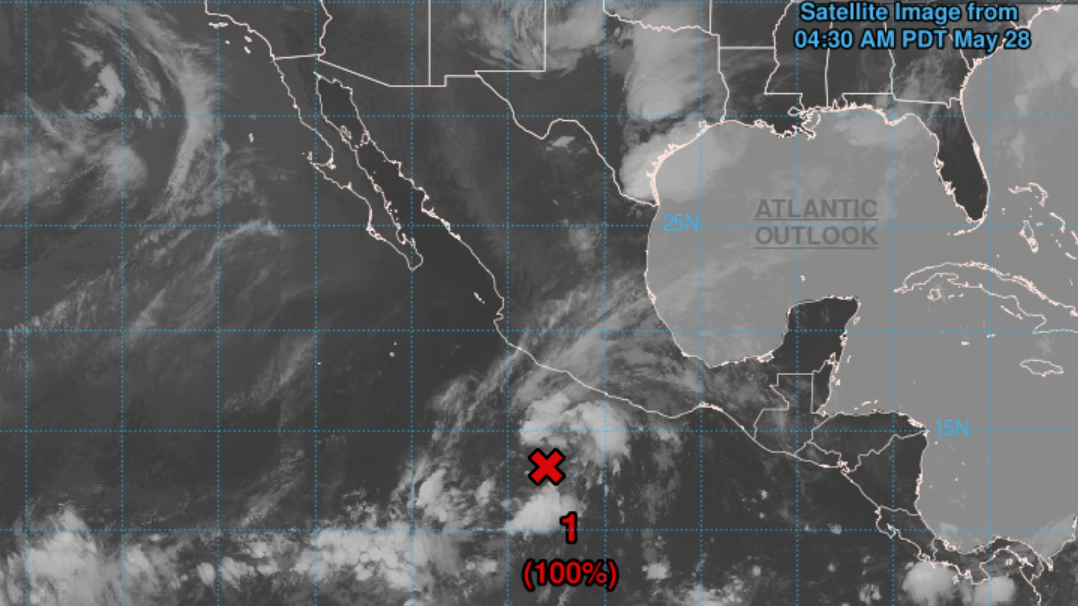Tropical storm Alvin will form in next 48 hours, forecasters say — kicking off this year's Pacific hurricane season
A tropical storm is brewing over the Eastern Pacific south of Acapulco. Clouds and thunderstorms that have been gathering for days will organize in the next 48 hours and could develop into a hurricane.

Rainclouds and thunderstorms off the Pacific coast of Mexico will likely trigger the first Western Hemisphere tropical storm of the 2025 season in the coming hours — with a chance this storm could strengthen into a hurricane, meteorologists say.
There is a near 100% chance that a tropical storm will form in the next 48 hours, according to the National Oceanic and Atmospheric Administration (NOAA)'s National Hurricane Center (NHC). Once the storm is confirmed, its name will be tropical storm Alvin, and it will have formed just two weeks after the beginning of the Eastern Pacific hurricane season on May 15.
As of 7:50 a.m. EDT on Wednesday (May 28), an area of low pressure producing heavy rain clouds and storms was located south of the coastal Mexican city of Acapulco. The system was moving in a west to northwest direction at a speed of about 10 miles per hour (16 km/h), according to the NHC.
"An elongated area of low pressure located several hundred miles south of the coast of southern Mexico continues to produce showers and thunderstorms, but the system still lacks a well-defined circulation," NHC meteorologists wrote on a map showing the location of the system. "Environmental conditions remain favorable for further development, and a tropical depression or tropical storm is expected to form later today or tonight."
The system's current direction of travel suggests that any tropical depression or storm born from it will fizzle out in the Eastern Pacific without making landfall, according to The Weather Channel — but it's possible that the system could curl around and migrate northeastward, with stormy weather hitting Mexico's coast around Saturday (May 31).
A tropical storm is a type of tropical cyclone with maximum sustained wind speeds between 39 and 73 mph (63 to 117 km/h). According to NOAA's National Ocean Service, meteorologists use the term "tropical cyclone" to describe any organized system of clouds and thunderstorms that originates over tropical or subtropical waters, and then starts to rotate in a closed, low-level vortex. The weakest tropical cyclones are called tropical depressions, and they are characterized by winds slower than 39 mph. Once maximum sustained wind speeds exceed 73 mph, tropical cyclones are called hurricanes.
Related: La Niña is dead — what that means for this year's hurricanes and weather
Get the world’s most fascinating discoveries delivered straight to your inbox.
Tropical cyclones are typically caused by pre-existing weather disturbances, but they also require high moisture and relatively light winds to form, according to the National Ocean Service. If the conditions persist for long enough, their combined effects will whip up violent winds and large waves, and potentially trigger torrential rain and coastal flooding.
According to The Weather Channel, a very strong Alvin could transform into a hurricane as soon as Thursday (May 29). Regardless of whether Alvin makes landfall, high surf, rip currents and heavy rain could hit parts of Mexico's coast later this week if the tropical storm develops, the broadcaster said.
It's unclear whether the storm could impact the U.S. West Coast, but scientists say the Southwest could receive more moisture than usual.
Tropical Storm Alvin likely to form in the Pacific over warm waters off coast of Mexico. Moisture will be dragged into the U.S. Southwest into the weekend. I'd expect Alvin to become a hurricane. No activity in the Atlantic -- yet, but could see something in 10-days. pic.twitter.com/zAB0uNA4W3May 27, 2025
Alvin may be the Western Hemisphere's first tropical storm of 2025, but it's very unlikely to be the last. The Eastern Pacific hurricane season starts two weeks before the Atlantic hurricane season, which runs every year from June 1 through Nov. 30, peaking between mid-August and mid-October.
This year's Atlantic hurricane season is expected to be particularly ferocious, with NOAA predicting above-normal activity and between 13 and 19 named tropical storms. Six to 10 of these storms will likely strengthen into hurricanes, and three to five could become major hurricanes, forecasters say.
The forecasted hyperactivity of 2025’s Atlantic hurricane season follows from 2024, as record-shattering ocean temperatures fuelled the rapid intensification of hurricanes such as Beryl, Helene and Milton, which sowed devastation across Florida and the Caribbean.
"For the second straight year, NOAA predicts an above-average hurricane season," CBS reporter Karen Hua said in a video. "Five hurricanes made landfall in the U.S. last season, causing more than $100 billion worth of damage."
While 2025's Atlantic hurricane season may bring above-normal tropical cyclone activity, NOAA predicts normal to below-average activity in the Pacific. In terms of numbers, forecasters think there could be 1 to 4 tropical cyclones between now and November.

Sascha is a U.K.-based staff writer at Live Science. She holds a bachelor’s degree in biology from the University of Southampton in England and a master’s degree in science communication from Imperial College London. Her work has appeared in The Guardian and the health website Zoe. Besides writing, she enjoys playing tennis, bread-making and browsing second-hand shops for hidden gems.
You must confirm your public display name before commenting
Please logout and then login again, you will then be prompted to enter your display name.


